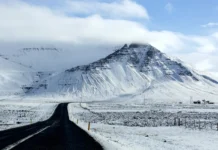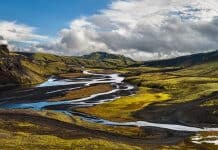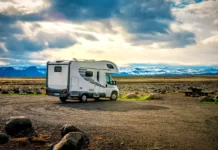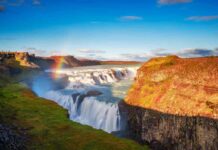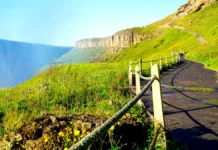Planning a road trip to Iceland is exciting. Just thinking about the waterfalls, volcanoes, hot springs, glaciers, and other natural wonders would make anyone giddy. But there are some more practical matters to take into account. Iceland driving is a unique experience, and keeping safe on the road is our primary concern. I’d like to share some information about Iceland driving safety to make sure you are prepared for what awaits you.

What are Icelandic Road Conditions Like?
Types of Roads
This is probably one of the most important things to be aware of. If you know what to expect, you’ll be better prepared to handle it. Let’s talk about the two types of roads you‘ll encounter when driving in Iceland.
The Ring Road and Paved Highways
Most travelers visiting us will drive around the country’s Ring Road. It encircles the entire island and is mostly paved. As a two-lane highway, there will be times when you might get stuck behind a truck or slow-moving vehicle. Be patient and practice caution if you decide to overtake them.
Safety Tip #1: Be careful of when the road changes from paved to unpaved
You’ll see a sign for this (Malkbik Endar), and when you do, be prepared to slow down. If you don’t reduce your speed when the road surface abruptly changes from paved to unpaved, it can be quite dangerous. You might lose control of your vehicle, and if you try to stop suddenly the breaks will lock up. You’ll skid even further out of control and might end up off the road.

Safety Tip #2: Pay attention to blind hills and blind corners
When you can’t see oncoming vehicles, slow down and steer slightly to the right. Other similar hazards are one-lane bridges (Einbreid Brú) and one-lane tunnels (Einbreid Göng). The driver closest to the entrance has the right of way. But if you want to be on the safe side, just pull over to the right and let them pass first.
Safety Tip #3: Watch out for sheep
This one comes as a bit of a surprise to many motorists who come to Iceland. Our beloved, furry little friends are allowed to roam free and enjoy the beautiful Icelandic countryside. Sometimes they end up taking a small break in the middle of the road, which proves to be a bit of a problem for drivers.
The sheep also get frightened by the sound of a quickly approaching motor, and when they get alarmed, they sometimes dart out into the highway. So even if the coast seems clear, you might suddenly find yourself getting into an accident with a scared and confused animal. And unfortunately for your pocketbook, you’ll have to pay the cost of the sheep to the farmer.
F-roads in the Highlands
The second type of road you’ll encounter in Iceland are called F-roads. These unpaved, mountain roads are located mainly in the Highlands (Iceland’s wild interior). They’re only open in the summer, and you need a 4×4 vehicle such as an SUV or a 4×4 campervan to drive in these areas. Sorry motorhome users and cars with 2WD, but F-roads are off-limits. The gravel-covered surface is too difficult a terrain for those types of vehicles to handle.
Safety Tip #4: Proceed with caution and keep your distance from other vehicles
The gravelly terrain of Iceland’s backcountry means that there are lots of little pebbles and small rocks that can go flying. These will damage the underside, body, and windshield of your rental, so try to go slowly and avoid other cars.
Safety Tip #5: Only cross shallow rivers
You’d be surprised at how many people think it’s ok to drive their 4×4 rental or SUV through rivers. They assume the chassis of the vehicle has a high enough clearance that they’ll be fine. But the water ends up deeper than they thought and suddenly their engine is underwater. Waterlogged motors are expensive to replace, and you’ll be 100% responsible for the damage. So just avoid this scenario in the first place and look for a shallow spot to cross.
 Snowy and Icy Road Conditions
Snowy and Icy Road Conditions
Iceland is a place that gets lots of ice and snow throughout the year. In fact, if you visit any time between November and April, you’ll find slushy or frozen roads. And during the other months, it rains a lot. Unless you’re lucky enough to be blessed with a sunny day, you’re almost always guaranteed to have slick and slippery road conditions.
Safety Tip #6: Follow the speed limit
Not only will this prevent you from getting a speeding ticket, but it will help you maneuver the sometimes tricky road conditions you’ll encounter. The speed limit in Iceland is:
- 90 km/h (56 mph) for paved roads in rural areas
- 80 km/h (50 mph) for unpaved roads in rural areas
- 50 km/h (30 mph) in rural areas
Iceland Driving: Safety Tips For Your Trip
Now that you know about Iceland driving safety, it’s time to move on to planning your trip. Check out our full library of articles on our Iceland camping blog.





